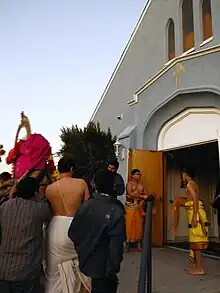Conversion of non-Hindu places of worship into temples
The conversion of non-Hindu places of worship into temples has occurred in India and elsewhere.

Definition
The identification of architectural terminology in relation to Indian architecture such as "Hindu", "Buddhist", "Muslim" or "Jain" is problematic. For example, following the current consensus that apsidal shrines are "originally Buddhist," and thus apsidal shrine used in Hindu temples reflect the conversion of an originally Buddhist temple, then Romila Thapar finds that apsidal shrines at Ter, India and Chejerla, India are Buddhist shrines that converted to Hindu structure as result of either gradual conversion or by force.[1] Another example would be the Durga temple in Aihole, India.[1] During the Partition of India, Delhi officials found Hindu idols being installed in mosques to "convert these sites symbolically into Hindu temples."[2] In response, police removed the idols and priests in some cases and even went so far as to destroy existing Hindu temples if found unauthorized or only claimed as Hindu after independence.[2]
Examples
Since 20th century, many non-Hindu religious sites in the West were bought and converted into temples to cater for the growing immigrant Hindu community there.[3][4][5] It is often homes and other buildings that become converted into temples.[6]
Babri Masjid, which was built at a site believed by many Hindus to be the birthplace of Hindu deity Rama was demolished in 1992 by a mob of Hindu Kar sevaks. The Masjid itself was in turn believed to be built on a pre-existing temple.[7] In 2019, the Supreme Court of India awarded the land to Hindu parties and directed the Government of India to establish a trust for the temple construction.[8] A similar size plot was also awarded to muslims to build a mosque.
See also
References
- Ray, Himanshu Prabha; Kulshreshtha, Salila; Suvrathan, Uthara (13 October 2022). The Routledge Handbook of Hindu Temples: Materiality, Social History and Practice. Taylor & Francis. ISBN 978-1-000-78581-4.
- Six, Clemens (2017-07-20). Secularism, Decolonisation, and the Cold War in South and Southeast Asia. Routledge. ISBN 978-1-351-68479-8.
- "Churches are turning into temples in UK and US! | Ahmedabad News - Times of India". The Times of India. Archived from the original on 2021-07-19. Retrieved 2021-07-19.
- "30-year-old US church to be convert into temple". TimesofIndia. Archived from the original on 14 September 2021. Retrieved 14 September 2021.
- Rose, David (1995). Hinduism. Folens Limited. p. 6. ISBN 978-1-85276-770-9. Archived from the original on 2023-03-31. Retrieved 2023-02-22.
- Rambachan, Anantanand (2019-11-05). Essays in Hindu Theology. Fortress Press. pp. 81–82. ISBN 978-1-5064-5313-2. Archived from the original on 2023-03-31. Retrieved 2022-12-04.
- "Babri Masjid not built on vacant land, artefacts reveal non-Islamic structure: Supreme Court". Business Today. 2019-11-09. Retrieved 2023-06-01.
- Phukan, Sandeep (2020-02-05). "PM announces Cabinet nod for Ram temple in Ayodhya". The Hindu. ISSN 0971-751X. Archived from the original on 2020-06-16. Retrieved 2020-05-09.